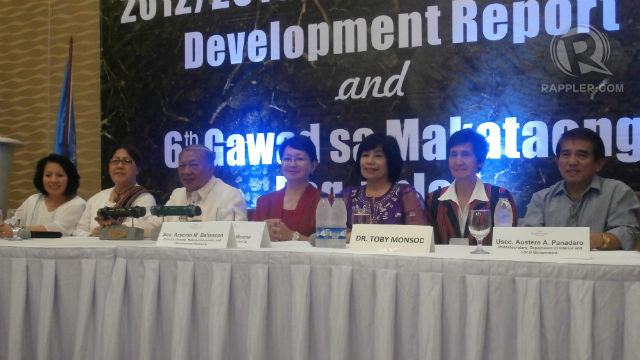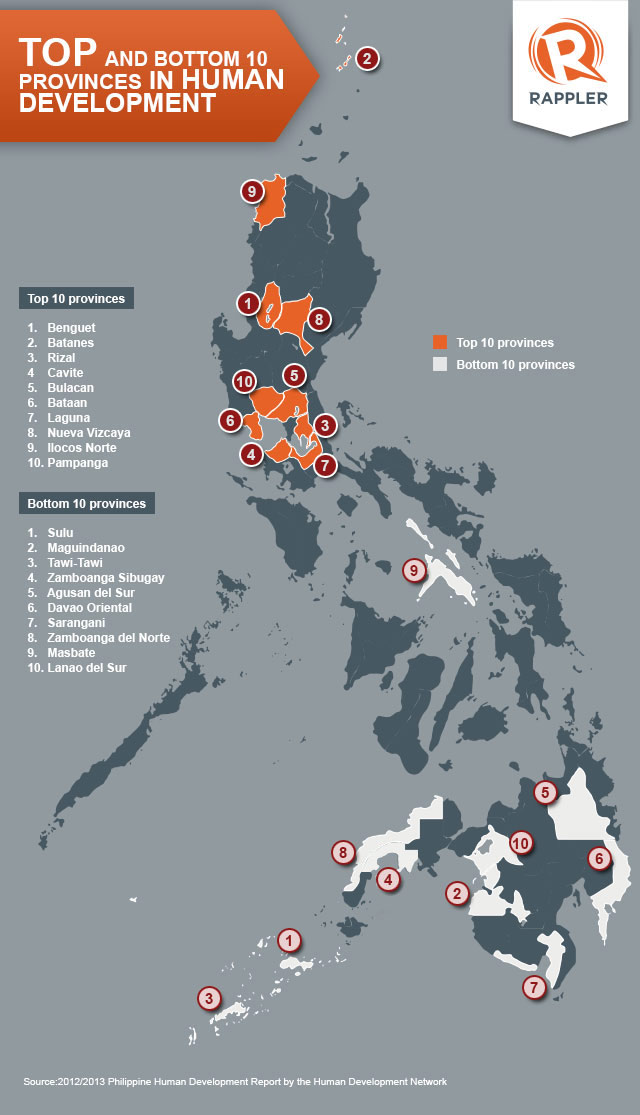SUMMARY
This is AI generated summarization, which may have errors. For context, always refer to the full article.

MANILA, Philippines – Ten provinces — all in Luzon — were cited for their performance in human development for 2009 during the launch of the Philippine Human Development Report (PHDR) on Monday, July 29.
This means that in 2009, they were the best performers in terms of per capita income, public spending on health, and schooling for its residents, among other factors affecting human development.
READ: Luzon areas score highest HDIs, Mindanao lowest
The 6th Gawad sa Makataong Pag-unlad awarded provinces that have scored the top human development index (HDI). The list was topped by Benguet, which scored 0.849. The complete list is as follows:
1) Benguet – 0.849
2) Batanes – 0.789
3) Rizal – 0.734
4) Cavite – 0.709
5) Bulacan – 0.699
6) Bataan – 0.698
7) Laguna – 0.695
8) Nueva Vizcaya – 0.678
9) Ilocos Norte – 0.641
10) Pampanga – 0.634

No improvements in Mindanao
Nine of the 10 bottom provinces in human development for 2009 are all in Mindanao. The only non-Mindanao province on the list is Masbate.
Sulu scored the lowest HDI with only 0.216. Below is the list of 10:
70) Lanao del Sur – 0.416
71) Masbate – 0.406
72) Zamboanga del Norte – 0.384
73) Sarangani – 0.371
74) Davao Oriental – 0.356
75) Agusan del Sur – 0.354
76) Zamboanga Sibugay – 0.353
77) Tawi-Tawi – 0.310
78) Maguindanao – 0.300
79) Sulu – 0.216
Lessons from Benguet
The PHDR 2012/2013 also analyzed the performance of provinces from 1997 to 2009.
A total of 5 provinces were considered as the most improved in the 10-year period in terms of human development. Four of these are in Luzon while one, Biliran, is in the Visayas.
Benguet again topped the provinces with a 0.128 growth in a decade. It was followed by Biliran (0.146), Cagayan (0.141), Nueva Vizcaya (0.093) and Catanduanes (0.114).
Benguet Gov Nestor Fongwan said the award is a challenge to further improve local governance. “Local governance is focusing on people. That’s really the bottomline of why government exists,” he added.
Fongwan stressed the importance of always looking for ways to improve the quality of life of his constituents. “Look for local sources (of income). Do not rely on IRA (Internal Revenue Allotment) alone. Maximize the use of the resources and see to it that it cascades toward the countryside,” Fongwan said.

The 10-year study highlighted the inequality and disparity across the regions.
In terms of human development for one decade, from 1997 to 2009, the largest “losers” also included 5 provinces from Mindanao. Davao Oriental, Maguindanao, Zamboanga Del Norte, Basilan and Tawi-Tawi were among the 10 less improved provinces during the 10-year period.
The other 5 in the bottom list are in Luzon – Batangas, Quezon, Laguna, Rizal and Batanes. Note that Batanes performed well in 2009, however.
Cagayan De Oro 2nd District Rep Rufus Rodriguez lamented the continuing low HDI results in Mindanao.
Why?
“We have seen this and we have centuries of inherited disadvantages for Mindanao. The worst part is that…in the improved category, none from Mindanao has improved,” Rodriguez said.
He added, “How come there is always a report every year and we have seen that the poorest are in Mindanao. How come that it’s still the same up to this present report?”
Senate President Franklin Drilon, who was the event’s keynote speaker, shared Rodriguez’s concerns. He said that budget allocation plays a crucial role in a province’s development.
“There must be a very conscious resource allocation so that everybody gets a fair share of the national resource,” Drilon added.
Drilon noted it’s also a matter of political leadership.
“Yes, we have to review budget allocation but maybe we should also review how well it has been implemented at the local government units,” he concluded. – Rappler.com
Add a comment
How does this make you feel?
There are no comments yet. Add your comment to start the conversation.